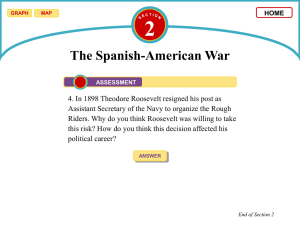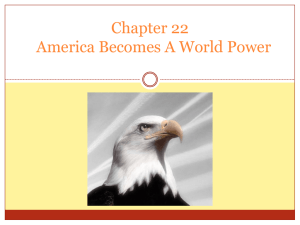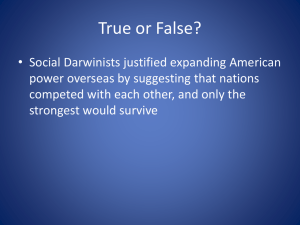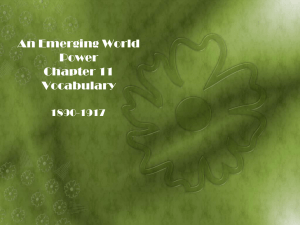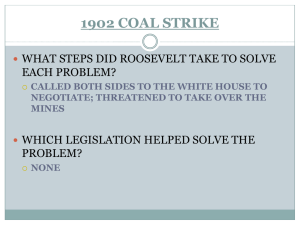File
advertisement
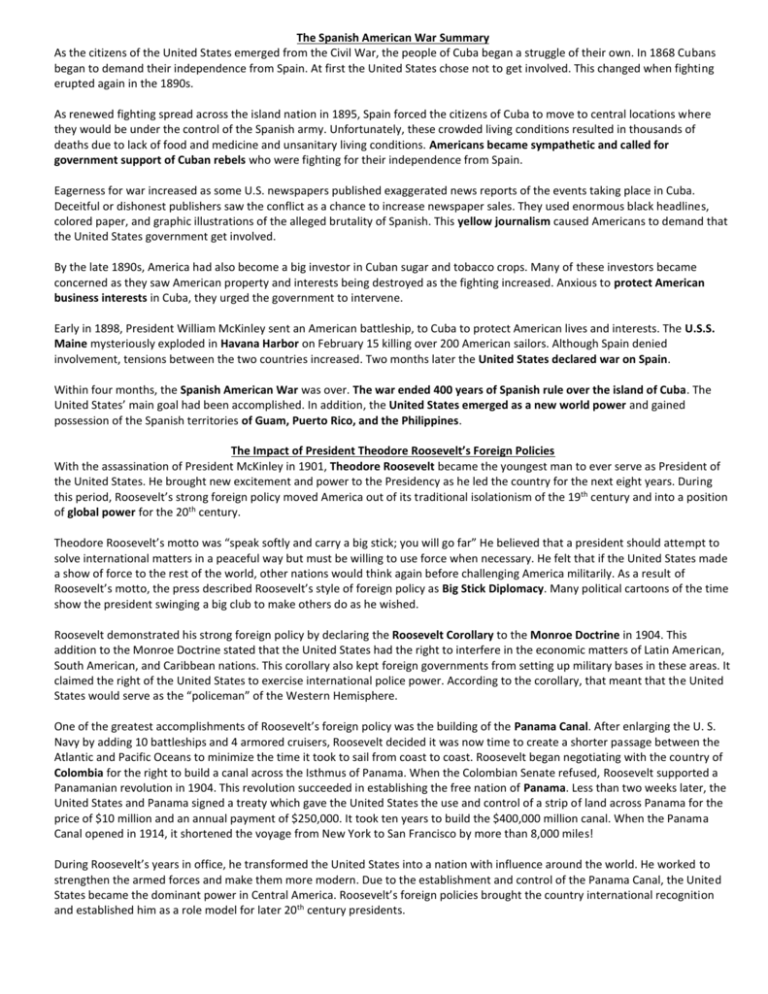
The Spanish American War Summary As the citizens of the United States emerged from the Civil War, the people of Cuba began a struggle of their own. In 1868 Cubans began to demand their independence from Spain. At first the United States chose not to get involved. This changed when fighting erupted again in the 1890s. As renewed fighting spread across the island nation in 1895, Spain forced the citizens of Cuba to move to central locations where they would be under the control of the Spanish army. Unfortunately, these crowded living conditions resulted in thousands of deaths due to lack of food and medicine and unsanitary living conditions. Americans became sympathetic and called for government support of Cuban rebels who were fighting for their independence from Spain. Eagerness for war increased as some U.S. newspapers published exaggerated news reports of the events taking place in Cuba. Deceitful or dishonest publishers saw the conflict as a chance to increase newspaper sales. They used enormous black headlines, colored paper, and graphic illustrations of the alleged brutality of Spanish. This yellow journalism caused Americans to demand that the United States government get involved. By the late 1890s, America had also become a big investor in Cuban sugar and tobacco crops. Many of these investors became concerned as they saw American property and interests being destroyed as the fighting increased. Anxious to protect American business interests in Cuba, they urged the government to intervene. Early in 1898, President William McKinley sent an American battleship, to Cuba to protect American lives and interests. The U.S.S. Maine mysteriously exploded in Havana Harbor on February 15 killing over 200 American sailors. Although Spain denied involvement, tensions between the two countries increased. Two months later the United States declared war on Spain. Within four months, the Spanish American War was over. The war ended 400 years of Spanish rule over the island of Cuba. The United States’ main goal had been accomplished. In addition, the United States emerged as a new world power and gained possession of the Spanish territories of Guam, Puerto Rico, and the Philippines. The Impact of President Theodore Roosevelt’s Foreign Policies With the assassination of President McKinley in 1901, Theodore Roosevelt became the youngest man to ever serve as President of the United States. He brought new excitement and power to the Presidency as he led the country for the next eight years. During this period, Roosevelt’s strong foreign policy moved America out of its traditional isolationism of the 19th century and into a position of global power for the 20th century. Theodore Roosevelt’s motto was “speak softly and carry a big stick; you will go far” He believed that a president should attempt to solve international matters in a peaceful way but must be willing to use force when necessary. He felt that if the United States made a show of force to the rest of the world, other nations would think again before challenging America militarily. As a result of Roosevelt’s motto, the press described Roosevelt’s style of foreign policy as Big Stick Diplomacy. Many political cartoons of the time show the president swinging a big club to make others do as he wished. Roosevelt demonstrated his strong foreign policy by declaring the Roosevelt Corollary to the Monroe Doctrine in 1904. This addition to the Monroe Doctrine stated that the United States had the right to interfere in the economic matters of Latin American, South American, and Caribbean nations. This corollary also kept foreign governments from setting up military bases in these areas. It claimed the right of the United States to exercise international police power. According to the corollary, that meant that the United States would serve as the “policeman” of the Western Hemisphere. One of the greatest accomplishments of Roosevelt’s foreign policy was the building of the Panama Canal. After enlarging the U. S. Navy by adding 10 battleships and 4 armored cruisers, Roosevelt decided it was now time to create a shorter passage between the Atlantic and Pacific Oceans to minimize the time it took to sail from coast to coast. Roosevelt began negotiating with the country of Colombia for the right to build a canal across the Isthmus of Panama. When the Colombian Senate refused, Roosevelt supported a Panamanian revolution in 1904. This revolution succeeded in establishing the free nation of Panama. Less than two weeks later, the United States and Panama signed a treaty which gave the United States the use and control of a strip of land across Panama for the price of $10 million and an annual payment of $250,000. It took ten years to build the $400,000 million canal. When the Panama Canal opened in 1914, it shortened the voyage from New York to San Francisco by more than 8,000 miles! During Roosevelt’s years in office, he transformed the United States into a nation with influence around the world. He worked to strengthen the armed forces and make them more modern. Due to the establishment and control of the Panama Canal, the United States became the dominant power in Central America. Roosevelt’s foreign policies brought the country international recognition and established him as a role model for later 20th century presidents. Name:________________________ Spanish American War Summary Questions 1. Complete the chart below. Causes of the Spanish American War (4 total) Results of the Spanish American War (3 total) 2. What is yellow journalism? Do you believe yellow journalism still exists today? Please explain. 3. Cause: 200 American soldiers are killed when the U.S. battleship USS Maine explodes in Havana Harbor. Effect: 4. Fill in the following blanks using countries. One country will be used more than once. During the Spanish American War, ____________________ and ____________________ fought against__________________. The fighting took place in _________________. 5. What was the effect of President Theodore Roosevelt’s strong foreign policy? 6. What was Big Stick Dipolmacy? 7. Multiple Choice _____ Which of the following best summarizes the Roosevelt Corollary? A. America would control the world with their military C. The U.S. controlled most of what happened in the Americas (including Latin and South America) and other countries should not interfere. B. All foreign countries were welcomed in the Americas. D. America would meet with Latin and South American countries to discuss and decide what military actions needed to occur against countries in Europe. 8. Why did President Roosevelt believe a canal should be built in Latin American? 9. What were the major accomplishments President Roosevelt achieved during his time in office?


